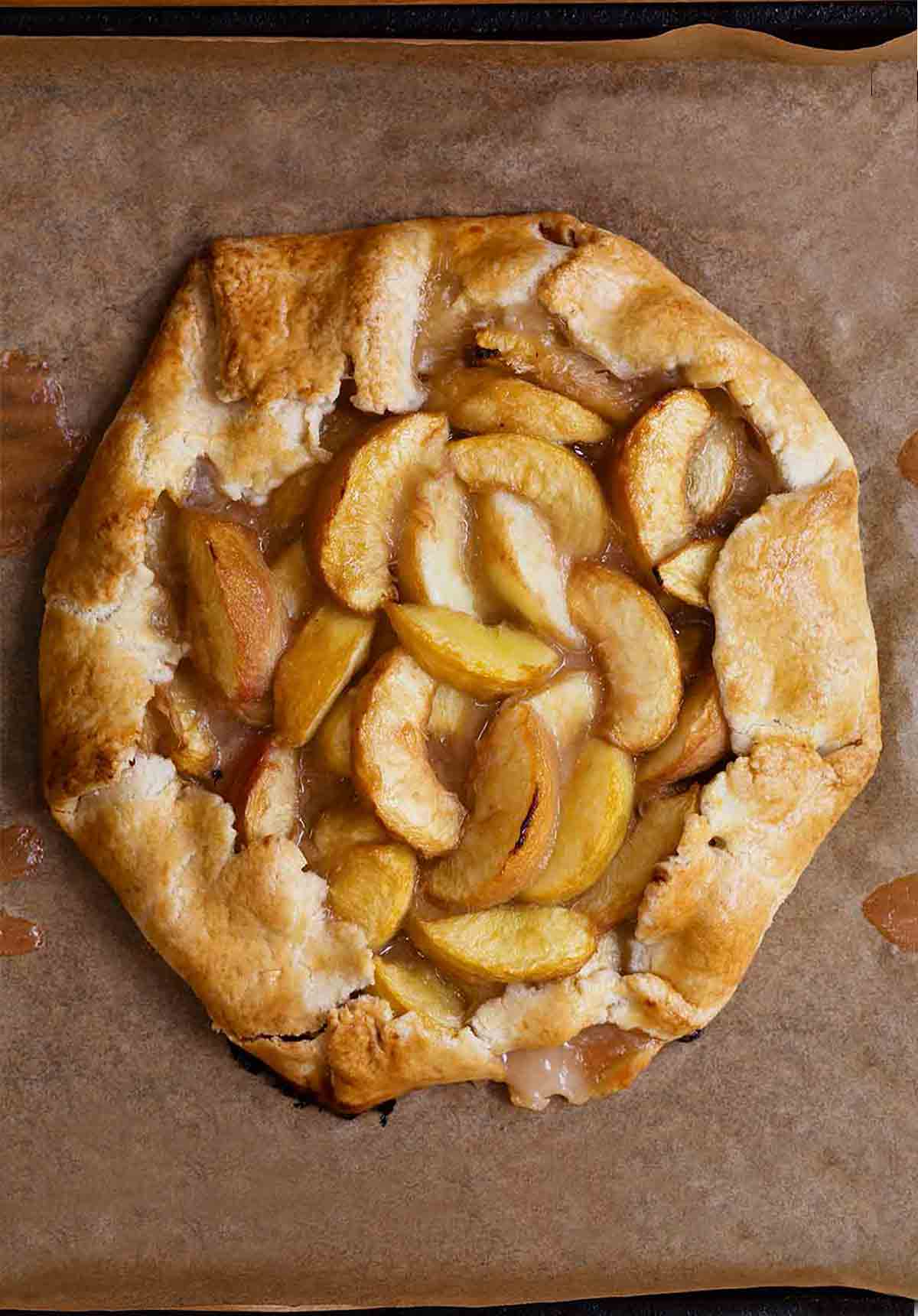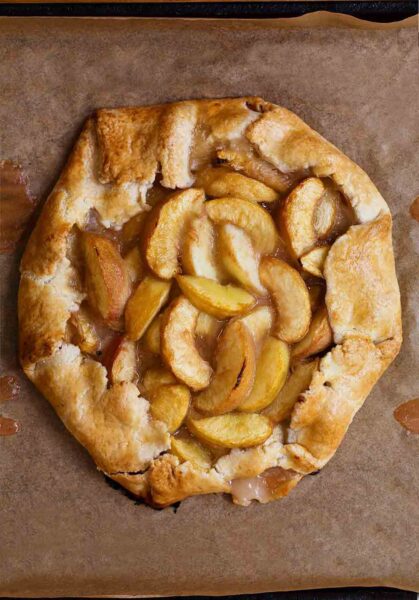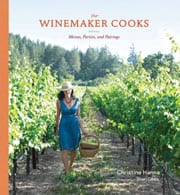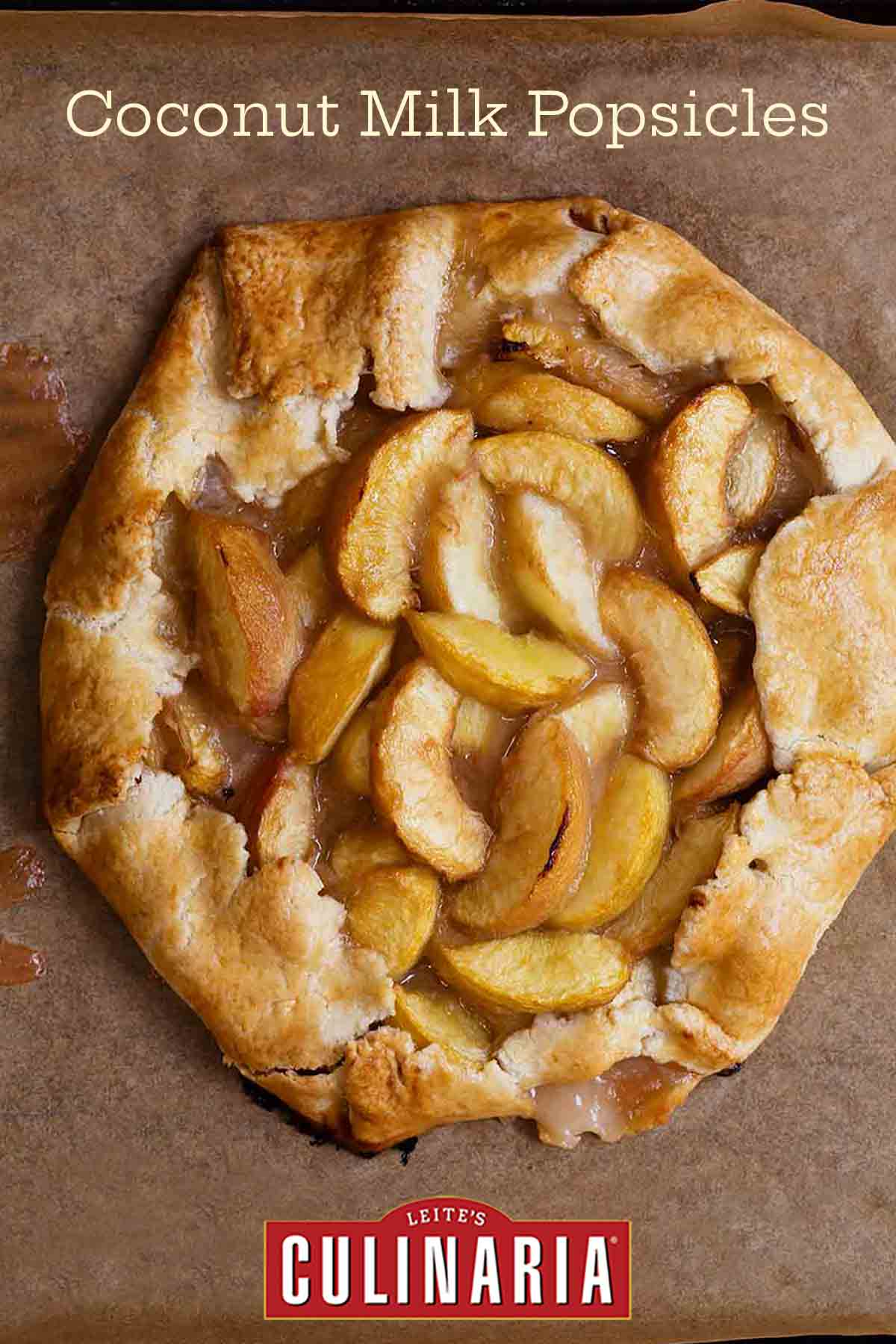
We have a white peach tree in our garden, and it’s the first of the summer stone fruits to ripen, even before the apricots. We grab baskets and fill them full of these fragrant, delicate peaches. We eat as many as we can out of hand, sticky juice dribbling down our arms and chins. Homegrown white peaches don’t last long and they bruise easily. They’re perfect for baking.
In the summertime, we find this peach crostata and a little ice-cold dessert wine to be a sweet, refreshing way to end a meal. Choose a late-harvest Sauvignon Blanc or, if you like bubbles, a slightly effervescent Moscato.
White peaches are also perfect for peeling, slicing, and freezing for later use. It’s amazing what a peach cobbler or crisp does for the spirits in midwinter!–Christine Hanna
LC A Little Leeway Note
Not familiar with the term “crostata”? We have a hunch you’re going to like what it means. A lot. Essentially a tart, a crostata is sorta like a less-fussy pie that’s often, though not always, free-form rather than fitted into a pie plate. It’s designed for nigh-perfect summer stone fruits, and pretty much all the home baker has to do is not get in the way of the luscious fruit flavors.
This peach crostata lends itself to “whatever stone fruit is in season and in abundance,” says author Christine Hanna. So you’ve got a little leeway. Doesn’t matter whether it’s peaches, nectarines, or plums. Leave the peels on nectarines and plums, cautions Hanna, but peel the peaches. Easy enough advice to follow. All of it.

White Peach Crostata
Ingredients
For the tart dough
- 1 1/4 cups all-purpose flour, plus more for the work surface
- 1/8 teaspoon salt
- 2 teaspoons granulated sugar
- 7 tablespoons (3 1/2 oz) cold unsalted butter, cut into chunks
- 3 tablespoons ice water
For the filling
- 1 to 2 tablespoons sugar, plus more for sprinkling
- 1 teaspoon cornstarch
- 4 to 5 white peaches, peeled, pitted, and cut into 1-inch (25 mm) slices (4 to 5 cups sliced peaches)
- 1 tablespoon fresh lemon juice
- 1/2 teaspoon vanilla extract
- 1 large egg, lightly beaten
Instructions
Make the dough
- Pulse the flour, salt, and sugar in a food processor until blended. Add the chunks of butter and blend just until mixture resembles pebbles. Add the ice water, 1 tablespoon at a time, and pulse just until the mixture comes together. Do not let it form a ball. It should should still appear to be pretty pebbly and shaggy.
- Turn the dough out onto a lightly floured surface and shape it into a disk. Wrap in plastic wrap and refrigerate for at least 30 minutes or up to 2 days.
Make the filling
- In a large bowl, stir together the sugar and cornstarch. Add the peaches, lemon juice, and vanilla. Let stand for about 30 minutes, until the peaches release their juices. Taste and adjust the amount of sugar according to how innately sweet your peaches are.
- Preheat the oven to 375°F (190°C). Adjust an oven rack to the center position.
- Remove the dough from the refrigerator and let it rest at room temperature for a few minutes. Roll the dough out on a piece of parchment paper to 12 inches in diameter. Transfer the parchment and the dough to a rimmed baking sheet.
- Pile the fruit mixture into the center of the dough, spreading it slightly but mounding it in the center. Fold the edges of the dough up around the fruit, allowing the dough to fall into pleats or seams every 2 inches. There should be at least 6 inches of fruit showing in the center of the crostata. Brush the edges of the dough liberally with the beaten egg and sprinkle with sugar.
- Bake the crostata for 45 to 50 minutes, until the crust is golden brown and the fruit is bubbling at the edges. If some liquid oozes out during baking, spoon it up and dribble it over the peaches in the center of the crostata.
- Transfer the parchment and peach crostata to a wire rack and let cool slightly or, if you can manage to resist, let cool completely. Cut the tart into wedges and serve.

Nutrition
Nutrition information is automatically calculated, so should only be used as an approximation.
Recipe Testers’ Reviews
This white peach crostata was delicious.
I made the tart dough in the food processor as suggested and it came together very quickly. I had cut up the butter and placed it in the freezer while I gathered all the other ingredients. It was a sunny day so my dough required all 3 tablespoons ice water. The dough looked pretty shaggy when I dumped it out of the food processor, so I kneaded it a little to make it look like a cohesive ball. Once chilled, it rolled out quite nicely.
The peaches were quite sweet so I only used 1 tablespoon sugar. We couldn’t wait for the crostata to cool completely. We ate it warm with a scoop of vanilla ice cream.
What a lovely way to celebrate summer. A slice of this crostata is like a bit of sweet, peachy heaven.
I would have liked to have more precise amounts for the peaches, such as weight or cups, rather than just the quantity of the fruit. I used approximately 4 cups fruit, which was a nice ratio for the amount of pastry. The addition of vanilla and lemon made a subtle yet pleasant enhancement to the peaches, and I think the amount of sugar in the filling is going to be very dependent upon the sweetness of the fruit itself.
After tasting my peaches, I added 2 more tablespoons sugar to the filling as my peaches weren’t quite as sweet as I would have liked. This turned out to be the right amount of sugar for my peaches. There was a nice amount of juice that leaked out during baking. I spooned this juice back over top of the peaches while the crostata was still baking, as it looked a bit dry on top. This gave the fruit a nice glaze and moistened the peaches a bit.
I used my homemade gluten-free flour mix and added a bit of ground pecans to it. For me it seems to stabilize the crust somehow. Perhaps it is not an accurate evaluation of their pastry, but I was happy with the flaky and rich pastry that resulted. Next time, I will sprinkle some sugar on the folded over edges of pastry.
All told, this is certainly worth making again and again, and would be a nice reminder of summer in the cold winter months if frozen peaches work well.
This recipe was a dream. I loved the end result and there wasn’t much work to get there. When I was done pulsing the dough, it was more like a streusel, though once I dumped it out on my work surface it came together easily. Once baked, I have to say, the crust was delicate, flaky, and flavorful.
We love white peaches. For us they are the third summer fruit to ripen, right after apricots and cherries. All three of them are on the market for a very short period, less than a month each. During this time I try to use them for cakes and desserts as much as I can.
As written, I used the food processor for the dough, even though I usually prepare this kind of crust with my hands in just a few minutes. Even if you don’t have a mixer, it’s possible to make this crostata. For the fruit filling I used 6 peaches because they were very small. Baking time was about 45 minutes.
We had it after dinner a few hours later, served with some vanilla ice cream. I’ll try it again in 2 to 3 weeks when the yellow peaches arrive.
This was so much fun to make. The simple, limited ingredients are great. I love the fresh fruit and the free-form, stress-free crust, which is beautiful when baked. I would suggest using the best-tasting fruit you can possibly find. All the flavors work together in the finished product and make for a lovely family dessert. Note: When processing, the dough looks like cookie dough before it forms a ball.
This is a delicious and easy-to-make peach crostata. I used yellow peaches instead of white because that’s all I could find. I think next time I’d add a little more sugar, especially if I use yellow peaches again, and I’d make it in a pie pan. Whenever I make a crostata, I always have trouble with the juice leaking out.
With so few ingredients, this recipe is utterly dependent on the quality of the peaches used. If you’re lucky enough to have access to local peaches in season, this crostata is a great way to show them off. My only tweaks were to add 1/4 teaspoon ground ginger to the filling. This was possibly even better the next day, after the flavor of the fruit had time to develop and meld.
This is a good basic white peach crostata recipe. I followed it exactly and it worked well. In the food processor the dough ended up looking like little pebbles; however, once it was turned out on the floured surface, it all came together. I used 4 ½ white peaches.
The peach filling was good, but it’s not that sweet and is almost a little on the bland side. Perhaps next time I may add some more peaches, some cinnamon or cake spice, or perhaps blueberries or grated ginger. I used my convection oven at 375°F (190°C) and only needed to bake it for 30 minutes. I served it with vanilla ice cream. This would be a good, light dessert at the end of a heavy meal.













Oh, yes, I know, but you put this idea in my head… 😉
I had some a week or so ago that were underripe, shall we say, and even those were good—sliced thin and dressed with an olive oil vinaigrette sweetened with a little brown sugar…OMG! So, even good when they’re “green.”
Heh. Oh, I know and understand well, ruthie. I think you and I are kindred souls in terms of white peaches. My world changed dramatically the day I first took a bite of one. I love the sounds of your olive oil and brown sugar vinaigrette, makes me almost think of doing this gado gado with firm underripe white peaches, swapping them for the green papaya—or, in the case of the recipe I linked to, green apples. Or maybe try them in this miang kam recipe shared by Ruth Reichl…? See what you’ve started? I’m off to find some white peaches today…! Many thanks!
Wow! Renee, thank you for those links. Yummm.
One last fave use for peaches that stubbornly refuse to ripen, ruthie…this simple, creamy, stone-hard peach slaw from chef Michel Richard, though it couldn’t be simpler.
Hope I’m not being a pest, but on that gado gado recipe, do you think quince would be too sour? They’re not something you would ordinarily eat without cooking, but maybe? I ask because I have a quince tree…;)
No, ruthie, not a pest at all. You know, I could be wrong, but I really think that quince would be too sour, too astringent, in that recipe. I guess you’re probably tired of making and eating quince paste, eh?
I was afraid of that.
Actually, we’re a quince and orange marmalade family. I don’t think my mom ever made anything with them, at least not that I can remember. 😉
Quince and orange marmalade sounds lovely, ruthie. Hmm. Perhaps you ought to consider a small preserves biz on the side?
I love white peaches! This sounds and looks fantastic. If I can still get them, I’m going for it. For people who find white peaches bland, try sprinkling on a little vanilla sugar before baking. Gives a hint of subtle flavor without screaming “Vanilla!”
Lovely tip, ruthie, many thanks. And you know, I love white peaches, too, although you *could* make it with regular yellow. Wouldn’t be quite the same, but, you know….
This looks delicious and sounds so easy to make. Thanks for sharing.
The pleasure is ours, Debbie! Love to hear about it when you make it.